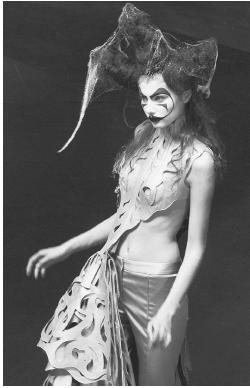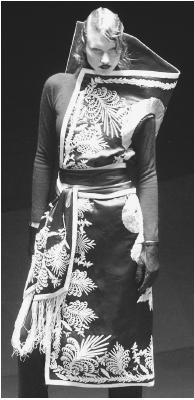Alexander McQUEEN - Fashion Designer Encyclopedia
English fashion designer
Born: Lee McQueen, London, England. Education: Left school at the age of 16; apprenticed as a tailor with Saville Row tailors Anderson & Shepard and later Gieves & Hawkes, 1990-92; M.A., St. Martin's School of Art, 1992. Career: Briefly worked with Koji Tatsuno, 1992; assistant to Romeo Gigli, Milan, 1993-94; launched his own line, 1994; succeeded John Galliano as head designer of Givenchy, 1997; sold 51 percent of his own label to Gucci, 1997; fashions currently available in London, New York, Paris, and Japan. Awards: British Designer of the Year, 1996, 1997, 2001. Address: 47 Conduit Street, London, England, W1R 9FB. Website: www.alexandermcqueen.com .
Publications
On McQUEEN:
Articles
"London Finale: Royalty and Rebellion," in WWD, 14 March 1995.
Fallon, James, "Totally British: A Trio of UK Apparel Designers Take the Plunge into Shoe Design," in Footwear News, 1 January 1996.
"McQueen Signs with Givenchy," in WWD, 11 October 1996.

Frankel, Susannah, "Bull in a Fashion Shop," in The Guardian, 15October 1996.
Foley, Bridget, "The Word from McQueen," in WWD, 16 January 1997.
Luscombe, Belinda, "What Would Audrey Think?" in Time, 21 July 1997.
Foley, Bridget, "McQueen Renews Givenchy Contract," in WWD, 11May 1998.
Raper, Sarah, "McQueen Eyes Shifting Show to New York," in WWD, 5 October 1998.
Horyn, Cathy, "McQueen's Audacity, Beene's Impishness," in the New York Times, 18 September 1999.
"African McQueen and Classic Burberry," in WWD, 17 February 2000.
Horyn, Cathy, "In London, Ho-Hum Ends in Smash Finale," in the New York Times, 1 October 2000.
Bellafante, Ginia, "Gucci Secures a Deal with Alexander McQueen," in the New York Times, 5 December 2000.
Givhan, Robin, "Givenchy's Loss, Gucci's Gain," in the Washington Post, 5 December 2000.
Menkes, Suzy, "A Farewell from McQueen," in the International Herald Tribune, 20 March 2001.
Fallon, James, "Alexander McQueen," in WWD, 5 June 2001.
"YSL Beaute Secures Alexander McQueen Perfume License," in PR Newswire, 13 June 2001.
"YSL Still Gets Backing of Gucci Despite Significant Losses," in Cosmetics International, 10 July 2001.
Banks, Jeff, "The Top Brass," in the Independent on Sunday (London), 22 July 2001.
"Worldwatch Trade Fairs & Exhibitions," in Financial Times Business Limited, 1 November 2001.
***
Alexander McQueen is most notably known as the genius of various tailoring techniques. He has audaciously set a different fashion stage in England, where his outlandish fashion shows have brought energy and attention to a fairly quiet and conservative fashion market. The last extreme attention London received was back in the 1960s when Mary Quant entered with the mod look. McQueen's clothes are beautiful and wearable, but he receives most of his attention for his outrageous personality and vibrant character. He is a designer with the stamina to pursue and conquer the world of fashion; by the dawn of the 21st century, McQueen was a fashion icon in the making.
McQueen grew up in London, one of six children of a cab driver and a homemaker. His family struggled financially while McQueen was growing up, so to help the family along, he starting making dresses for his three sisters. At this point, his desire to become a fashion designer began to evolve. He expressed an interest to his parents about a career in fashion, and they were against it. "I was the pink sheep of the family!" McQueen told Elle magazine. His parents later became extremely supportive of his career and very proud of his accomplishments.
McQueen has truly grown up in the eyes of the fashion press. He left school at the age of 16 and landed an apprenticeship with Saville Row tailors Anderson & Shepard, later working for Gieves & Hawkes. McQueen has said, "It is important to learn the basics of cut and proportion." Through his apprenticeships, he mastered six methods of pattern cutting, from the 16th century to the present; his talented tailoring techniques are well known within the fashion industry.
At 20, McQueen worked as an assistant to designer Romeo Gigli in Milan, who was extremely impressed with his skills. After a short period working for Gigli, McQueen returned to London to study at Central St. Martin's College of Art and Design. He wanted to be admitted into the Masters of Art program but lacked a formal education. He showed his portfolio to the director of the school, who was very impressed with the work, and admitted the fledgling designer immediately. McQueen's first international exposure came while presenting his final collection at St. Martin's, and he received an enormous amount of press coverage.
McQueen launched his own line in 1992 and on one occasion used crushed beetles and human hair in a fashion show. His presentations have always been full of unpredictable magic and madness. "In the past, he has dressed models in chadors and hoisted them into the air, where they did somersaults and pirouettes until finally miming their own electrocution," wrote the Washington Post in December 2000. In

Within two years, McQueen was unhappy at Givenchy, and in an interview in Arena magazine, dared his employers to fire him. But before his contract expired, he sold a 51-percent stake in his own label to rival Gucci. Owning the remaining interest in his company still allowed him to have full creative independence. During the breakup with Givenchy, McQueen produced some of his most beautiful clothes to date in his career. The show once again was very controversial, with the setting in an insane asylum. The show, however, confirmed his reputation of producing fashion with an edge.
In the early 2000s, McQueen was concentrating on his own label under a Gucci-McQueen partnership. He was quoted in an article in WWD (5 June 2000) saying, "It hasn't been as easy as it seems leaving Givenchy and being able to focus strictly on McQueen. Now I'm seeing all the mistakes we made in the past…. At some stage, you have to grow up. It's important now that people focus on the clothes rather than someone in a clown suit." McQueen continued working on his own line, redesigning the label and packaging, a new store design, preparing the launch of a fragrance in 2003, considering a cosmetics line under the Gucci Group, as well as overseeing the licensing of his eyewear.
Alexander McQueen is a designer who has carved his own career path in the fashion industry. He is a workaholic who keeps moving forward despite the sometimes negative media surrounding him. He is an artist, not just a fashion designer, who does not let the commercial value of his clothing take away from the controversial presentation necessary to draw attention to his creations.
—Donna W. Reamy
Comment about this article, ask questions, or add new information about this topic: